Leading Your Cat to Water and Getting Her to Drink It
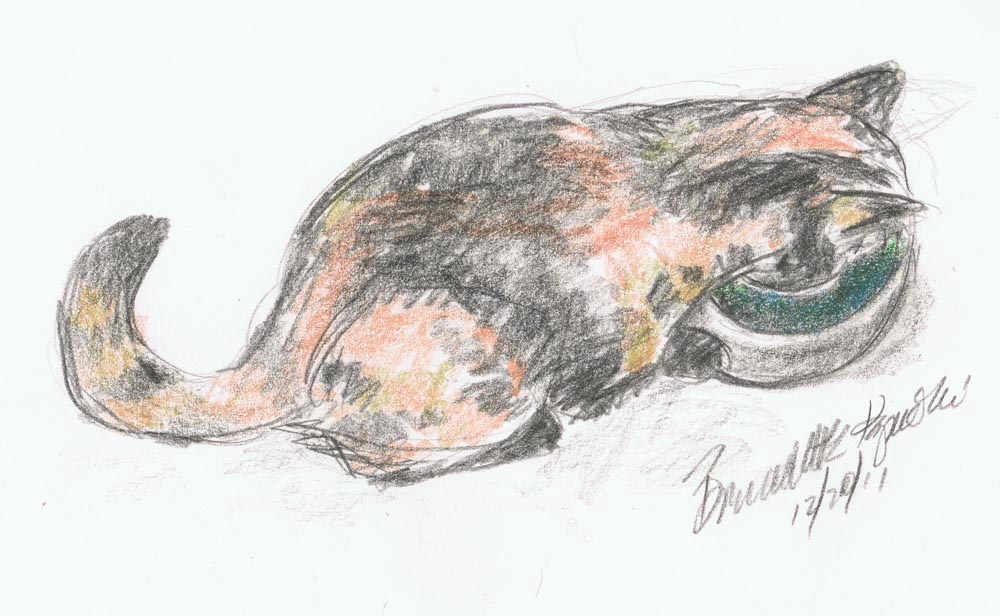
Years ago while discussing 20-year-old Peaches’ needs for fluid therapy as we treated her renal failure my veterinarian mentioned that most cats seemed to be in a state of some dehydration, and at about the same time I had the same conversation with my mother’s doctor concerning human beings, especially the elderly. Keeping the body hydrated is as important as, if not more important than, nutrition from food—the body can’t even digest food properly if it’s not properly hydrated. Both doctors independently remarked that their patients would be much more comfortable and medications would have a better effect if they could be convinced to drink more water. Peaches wasn’t hard to convince, but my mother was never in her life willing to drink water.
It’s a year-round issue, but once the weather warms up it’s even more critical for cats, and age and illness can make it urgent. Dehydration is a serious medical condition that can lead to organ failure and death, and even mild dehydration can cause damage and leave long-lasting effects on the body.
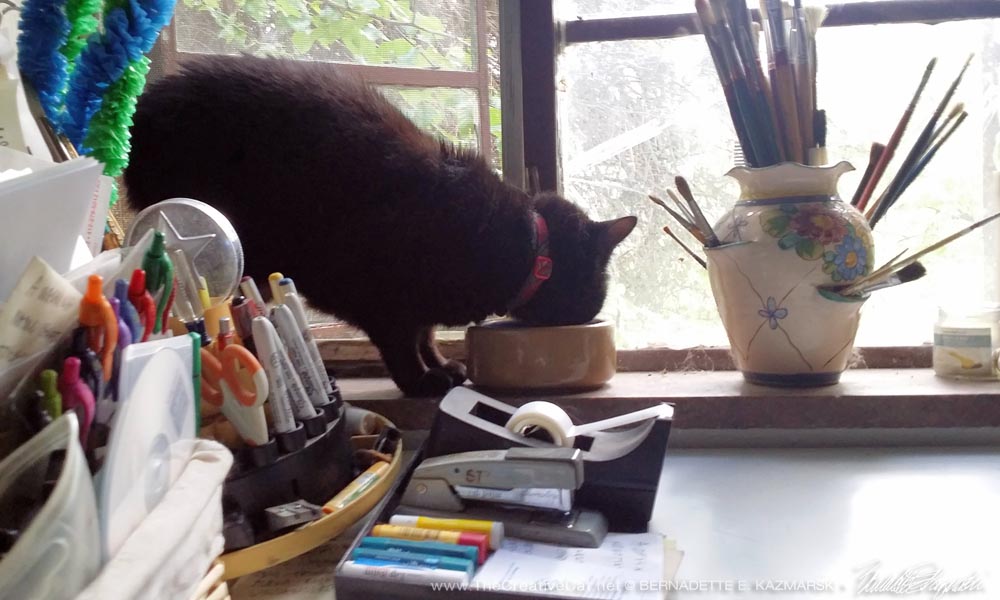
How much should your cat drink each day?
Cats need an average of four ounces of water per every five pounds of body weight, so, for instance, Mimi needs about five ounces a day. Wet food is generally about 70% water, the same balance as their ancestral prey species, small rodents. To do a little math, a 3 oz. can of wet food contains about two ounces of liquid. If Mimi eats the equivalent of two per day she gets a little over four ounces of water, close to what she needs, but not enough. Say I add about a tablespoon (1/2 oz.) to each can, a little at a time as I feed her through the day, so she gets another ounce of water totaling five ounces. She also drinks from the fountain frequently, so she gets even more. Cats can never have too much water especially as they age, but be on the lookout for suddenly high water consumption and high urine output which can indicate metabolic illnesses.
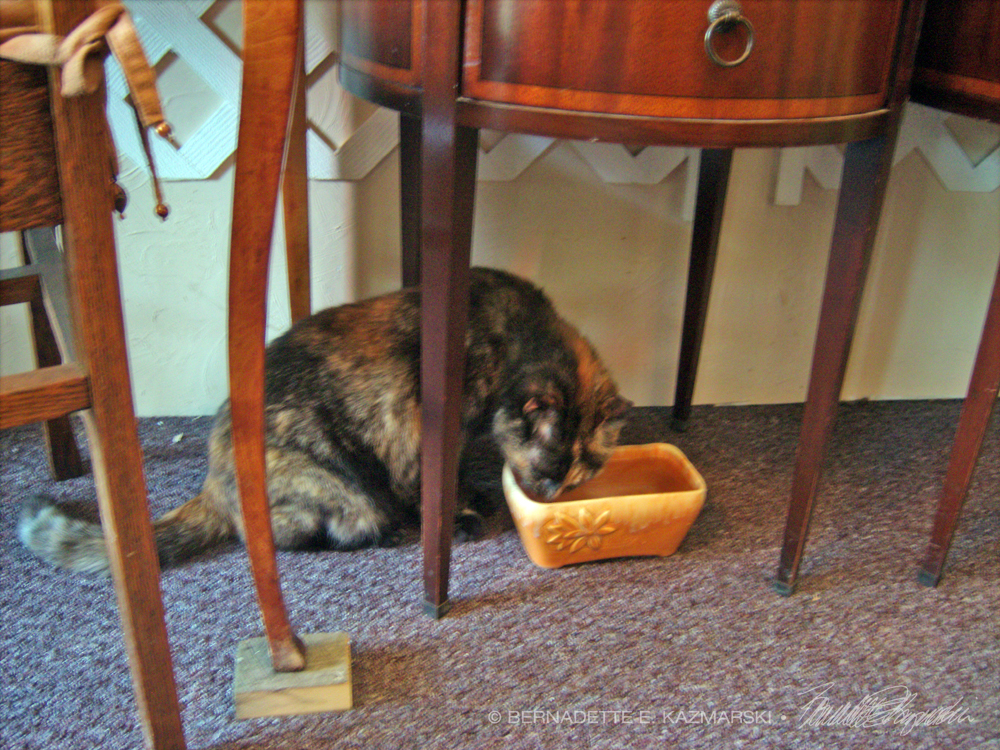
A cats’ biology and fluid intake
But you never see your cat or cats drink water and the level hardly seems to change in the bowl each day. You can see by the example with Mimi above, if you feed canned they only need to drink a few ounces, so chances of seeing them drink or seeing the water level drop are slim. Don’t rely entirely on your observations.
Cats will give us two reasons why they don’t just drink water: their natural prey of small rodents, birds and insects averages 70% liquid which offers almost enough hydration, and cats evolved in the desert and adapted to a scarcity or lack of water by concentrating their urine so they could survive on less water. Most of our precious pampered kitties don’t hunt rodents except as a sideline and most don’t live anywhere near a desert, but their biology still seems to tell them to make do with what they have.
The other is that they are biologically particular about the way water is provided to them. Picky? No, again, their biology wins. Just like the litterbox, think of:
- placement,
- container style and size,
- what it’s filled with,
- how often it’s cleaned,
- and understand a cat’s instincts around consuming water.
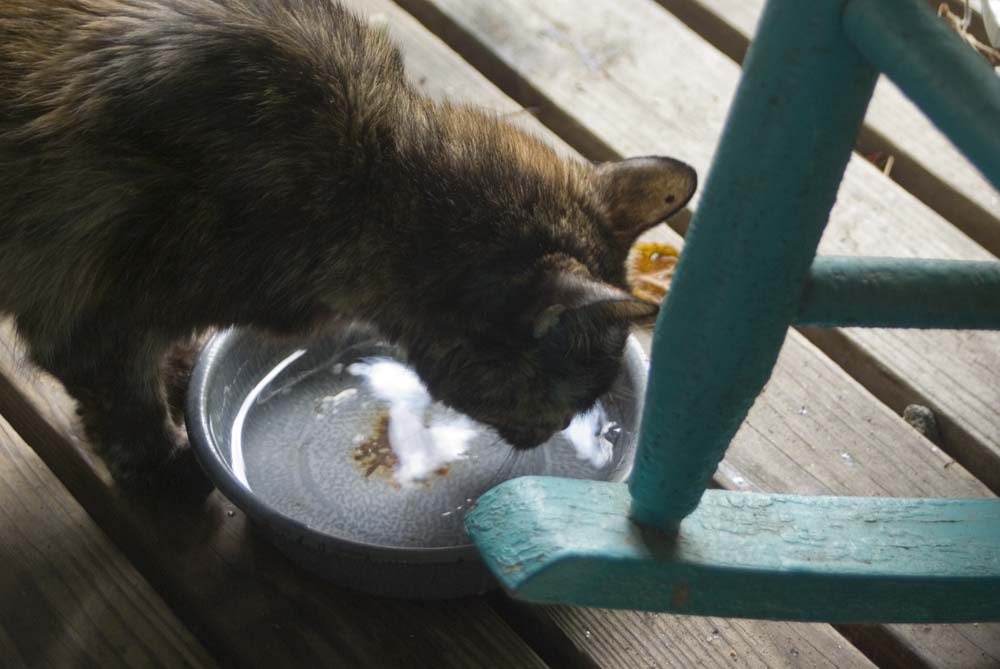
Maintaining the water bowl
Maintaining the water bowl is just as important as its presence.
- Whether it’s a fountain or a container of still water, keep it clean and don’t wait until it’s empty to refill it. Despite the fact that the water may look fine, after a day a bowl probably has a layer of dust and fur and other household particles that float in the air and land in the bowl because it’s typically on the floor.
- You should change the water in the bowl every day and wash the bowl when you do, so you don’t need a large bowl—a smaller, shallow bowl more like a cereal bowl works best so they don’t have to reach too far inside it.
- You should also keep the bowl separate from food dishes because cats prefer it that way, often feeling their water is unclean when it’s next to their food.
- And a raised water bowl, even just on a sturdy two to three-inch box, is helpful for any adult cat.
- If your cat goes outdoors for any length of time you should also provide a water source there, and maintain it as scrupulously as the bowls indoors.
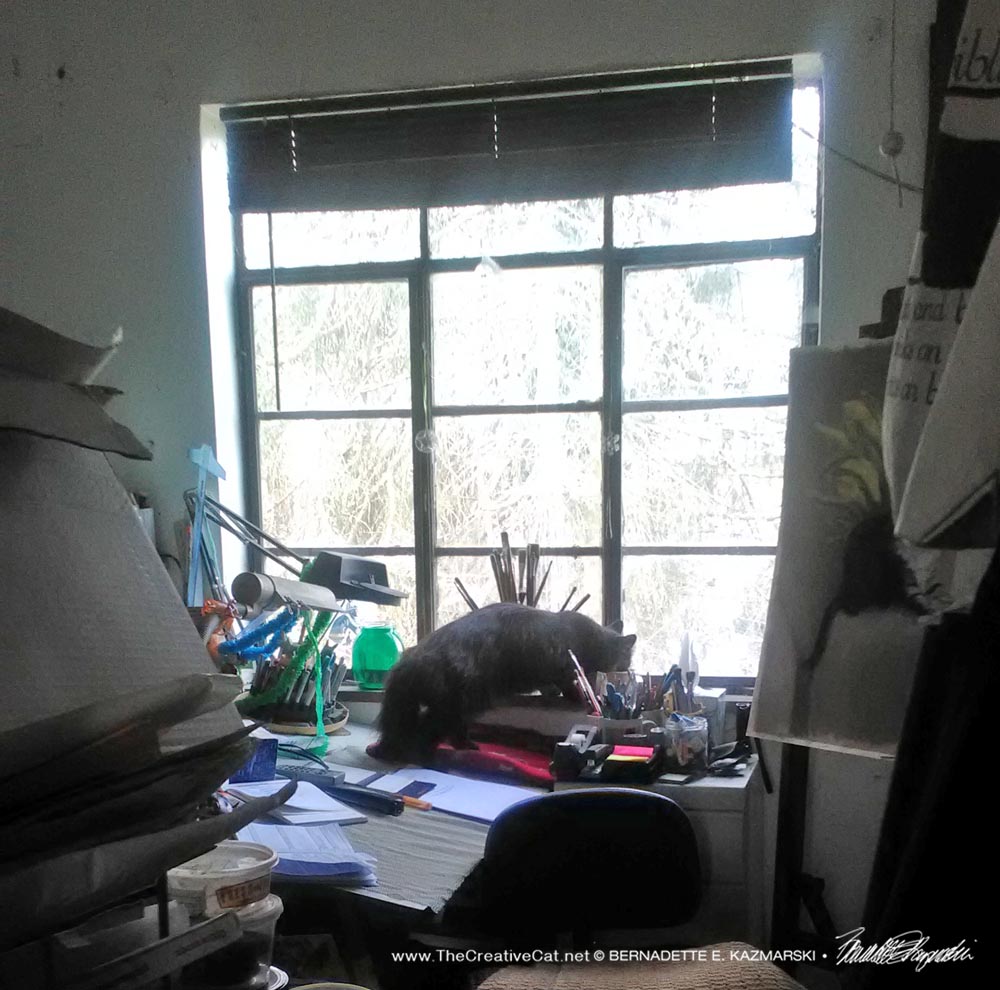
Placement
Think of animals and nature, drinking holes being places where many animals gather, many animals who are predators to cats, and understand that while drinking, they feel vulnerable. Find a place where they can feel protected, but not trapped, and especially not in a high-traffic area.
Provide more than one water bowl so they can choose, or for convenience especially if the cat is a kitten or an elder. Just as cats will not pass up an opportunity for a meal whether you are handing it out or a little mouse runs by, they’ll also take a sip from a trusted water source when they pass by it, so more bowls around the house becomes more water consumed.
Also, don’t place a bowl near their food. If the bowls are right together, particles of food will land in the water and contaminate it, and cats will not drink it for that reason. Cats also consume food and water in different places in nature, and most animals instinctively know that having their prey near their water source could contaminate it. Given the choice of food and water together cats will eat the food and leave the water. Consider the water separate from the food, and provide it that way.
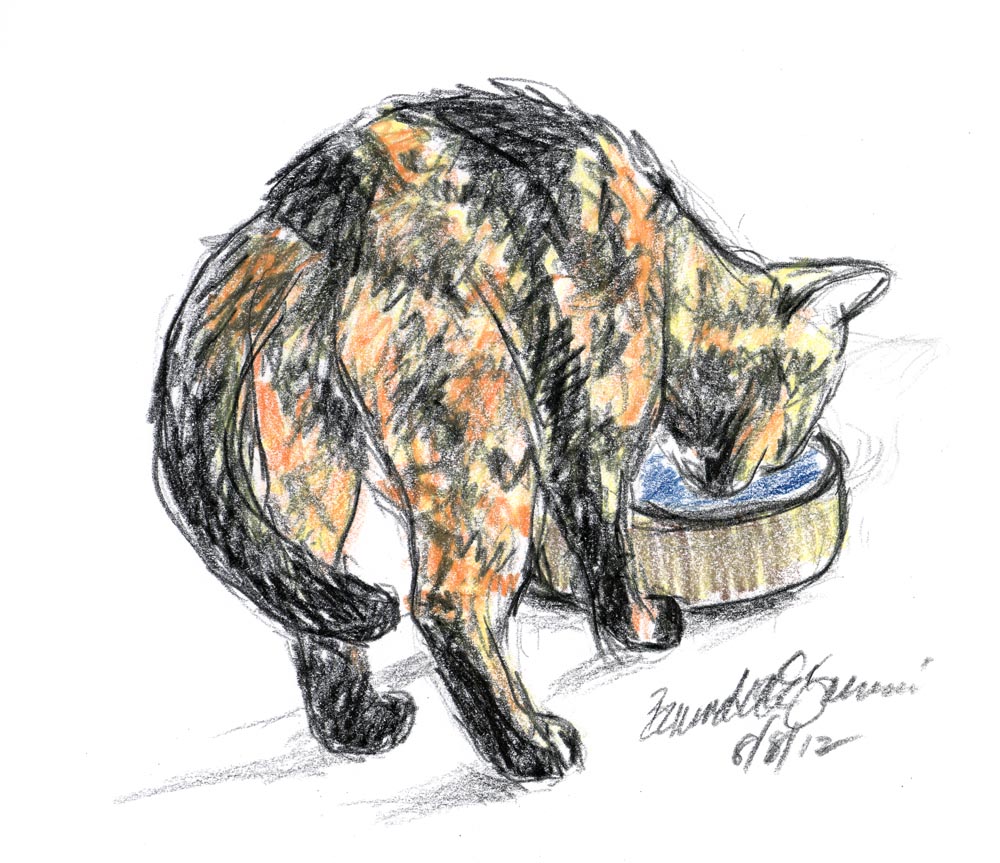
Container
Choose a container that has no natural scent and doesn’t impart a taste of itself to the water. Plastics can be a scent culprit because most plastics have a scent to them especially when you have your face in them drinking. They may also have soft surfaces that become scratched or abraded when being used or when cleaning, and these can hold saliva, food particles, or pathogens that may develop, even with a good scrubbing. Some harder plastics or nylon work well, along with stainless, ceramic, and tempered glass.
The bowl should also be comfortable for your cat to drink from, not too deep to dip their faces into or so shallow that the water grows stale or evaporates. Don’t choose a large bowl so your cat has days worth of water and leave it filled until it’s dry—remember that your cat only needs a half cup to a cup of water each day depending on their size. The water grows stale in a day and it’s no longer appealing, and then it’s also a magnet for environmental stuff, so of course they won’t drink it. A smaller container is a better choice.
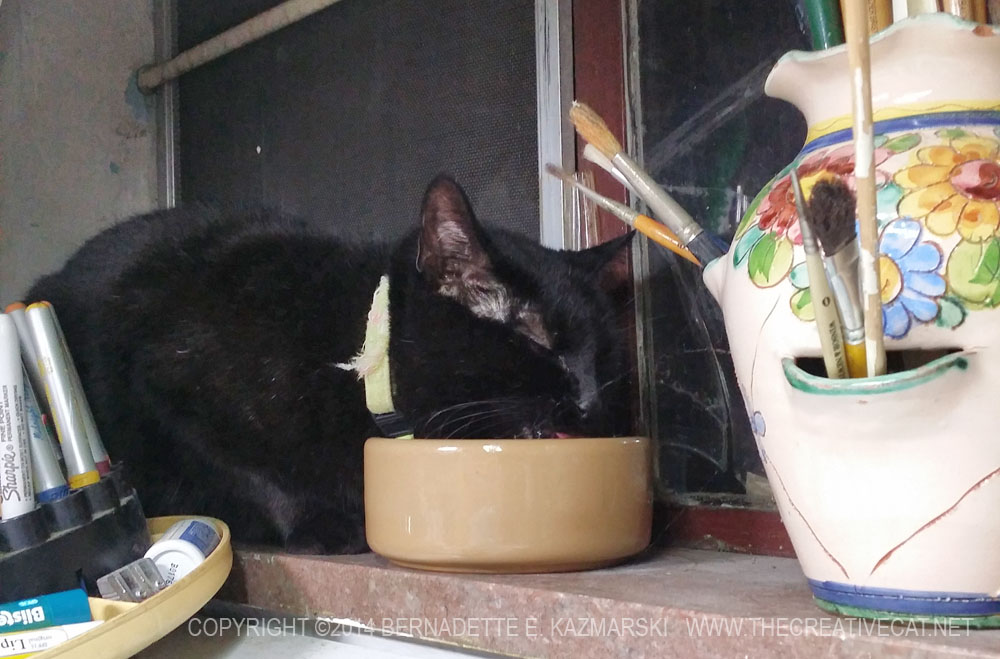
The water itself
Your tap water may taste fine to you, but drink some filtered or spring water then taste it again and see if you detect a metallic taste or other flavors. You can try a water filter or some bottled water to see if your cat drinks more.
Clean bowl and fresh water
Wash the bowl and change the water daily. Cats add saliva to the water when they drink and this again contaminates the water and after several drinks that water is done. Water bowls are typically on the floor, where dust and fur and all sorts of other nearly invisible things float, then land on the surface of the water, and on the bowl itself. Their ancient biology will tell them this water is unsafe.
Extra hydration in heat
For extra hydration for your pets, you can add extra water bowls around the house and add ice cubes to their water if it’s especially hot.
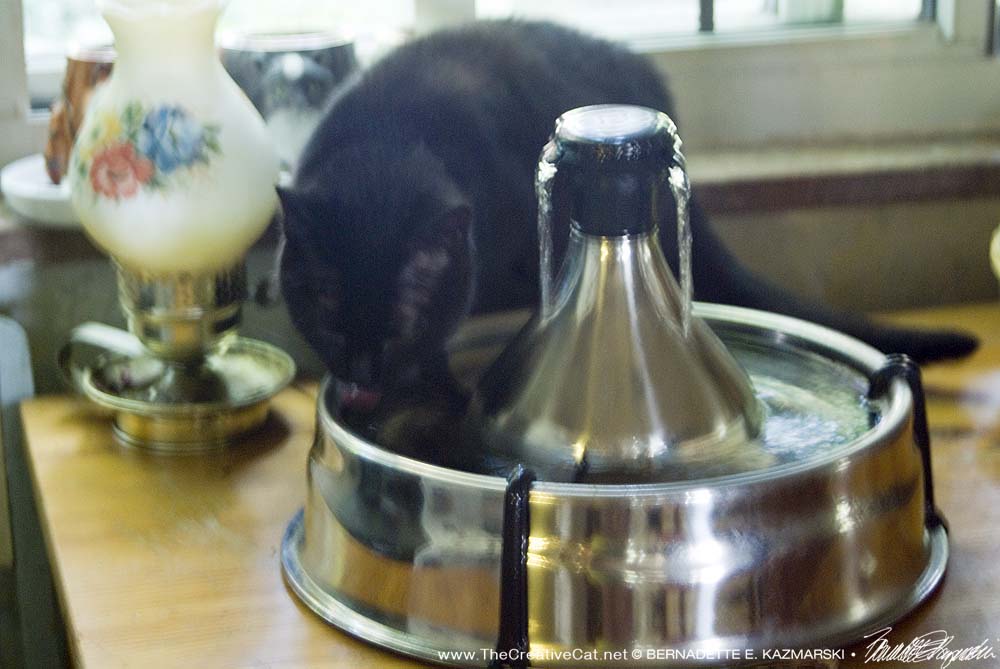
Fountains
A fountain is closer to a cat’s natural need for a water source because they prefer moving water to still water, as do many wild animals. In that way it also provides them with a little bit of environmental enrichment all on its own by giving cats a more natural way to drink their water, hearing it and seeing it move being part of the appeal.
Fountains are handy because they keep the water fresher and most animals are attracted to moving water because it has less chance of harboring pathogens. Some cats may not seem to be interested in fountains but it’s a good idea to try one for them because if they do like to use it, they often drink more water than from a bowl. Fountains may be a simple bubbler that keeps the water moving and oxygenated, or they may be a spout that flows into a bowl, and some provide water in three ways, from a spout, landing on a sluice or a slope it runs down into the bowl, and in the bowl itself. Cats have preferences for each one.
Follow the fountain’s maintenance and care instructions for changing the water, cleaning, and filters.
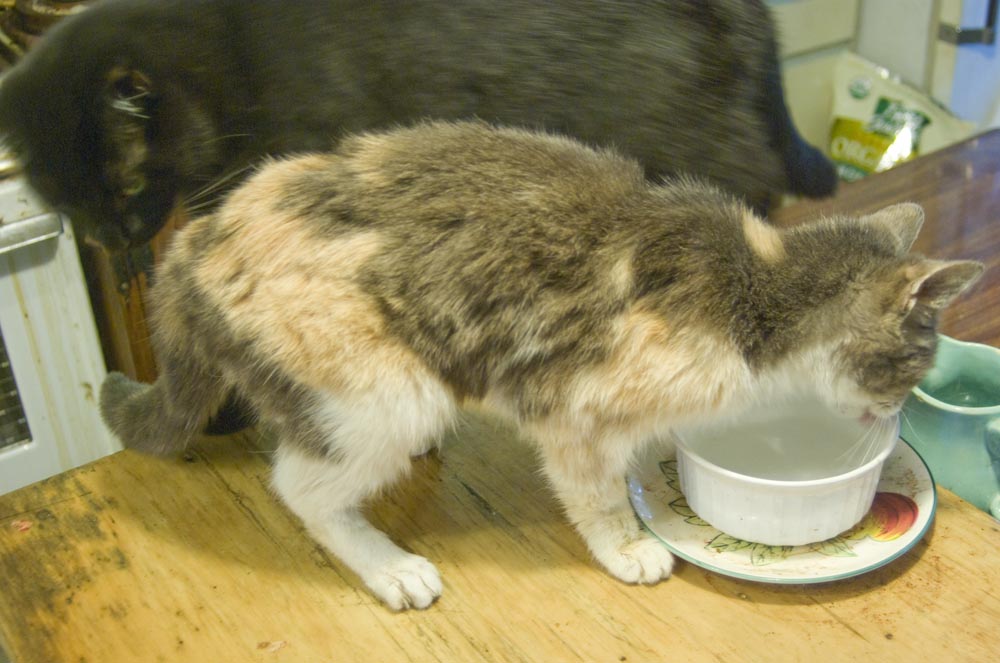
Water and senior cats
Water is important to cats at all life stages but especially as they age, when even in humans organs may slow down their function and not process fluids as efficiently. Add extra water dishes around the house so that fresh water is available wherever your senior cat spends time, especially napping. When Moses was entering senior years a couple of decades ago I added water bowls to the second floor and basement because she had some mobility issues and liked to nap on all three floors, and she sipped from each of them as did the rest of my cats. Over the ensuing years for Stanley and Peaches and all the rest I added water bowls to each room, even on windowsills, and continued to maintain them. All are regularly used even now.
Feeding primarily or only wet food as well as adding a little extra water to canned food also adds liquid to the diet passively so your cat doesn’t even have to find a water bowl for some of their daily intake, and the extra water in the stomach with the food helps to digest it as well as helping keep from developing harder, dryer stool that may cause constipation.
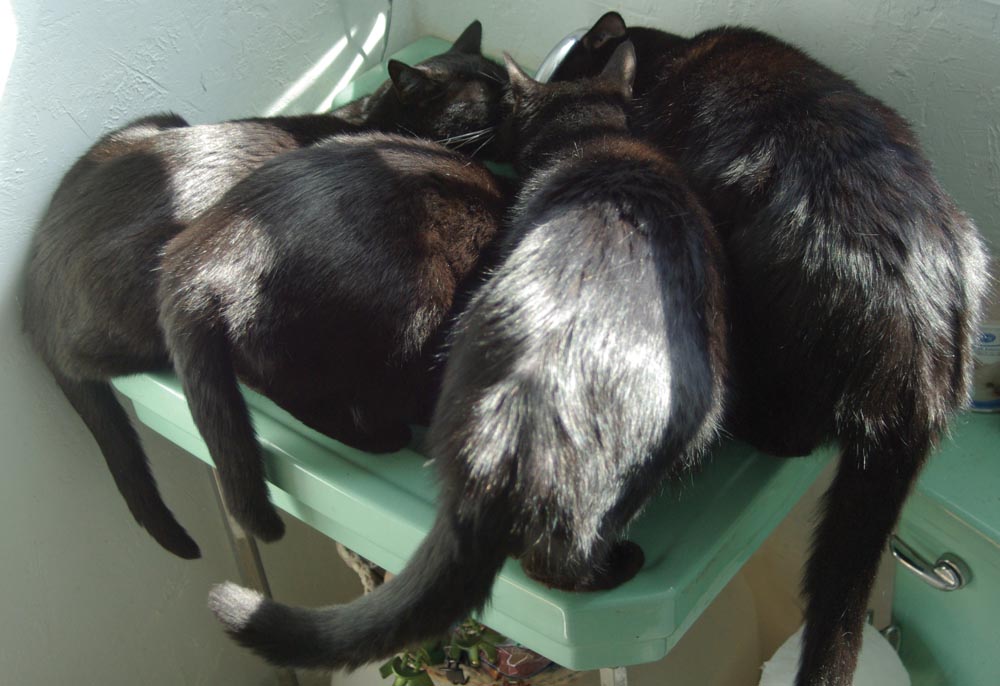
Drinking from faucets, and such
Cute as that may be, it’s not a good idea to have a cat develop a preference for a water source that isn’t available all the time. When I fostered my four black sibling cats in the bathroom, all the faucets leaked and did indeed provide a constant source of both fresh water and fun. Because it was in their environment they drank from it all the time, even after they’d been released from foster into the rest of the house. When I had the bathroom renovated two years later that water source was gone and I even had the bathroom completely rearranged, but I still had to ease them over to water bowls. I actually placed water bowls under the faucet in the tub and sink and also had one on the floor. Eventually they did give it up, though every so often one of them asks for the faucet to be turned on. I purchased the household a fountain a couple of years later and though it’s not in the bathroom, they do enjoy it.
Drinking from the toilet may seem strange, but cats and dogs don’t really think of it as a place for waste, they see it as a big water bowl, especially if you don’t change and wash your water bowls regularly. Every time you flush it fills with cold fresh water, exactly what they want. But it’s plain unsanitary, just put the lid down and maintain your pet water sources.
And if they should drink your paint water, and I can tell you from experience they always think it’s the most special water they’ve ever had, make sure your materials are all tested AP non-toxic.
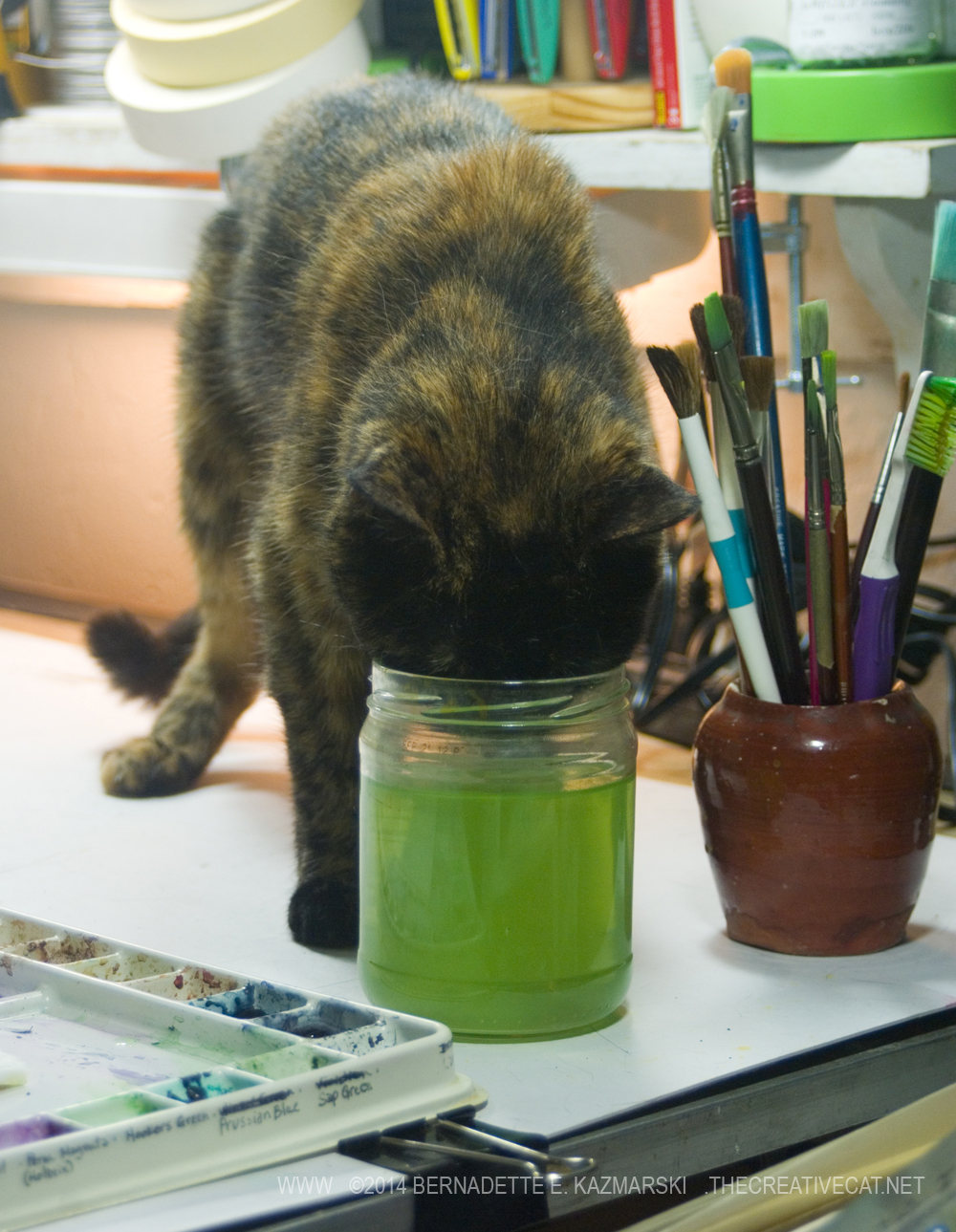
References:
Giving Your Cat Clean and Fresh Water: https://www.cathealth.com/cat-care/nutrition/1248-cat-drink-water
The Importance of Drinking Water for Your Cat: https://www.hillspet.com/cat-care/nutrition-feeding/drinking-water-can-save-your-cats-bladder
Cats Need Water: https://www.catbehaviorassociates.com/cats-need-water/
How to Lead a Cat to Water AND Make Him Drink it: https://www.vin.com/vetzinsight/default.aspx?pId=756&id=7543638
How Much Should Cats Drink?: https://www.petmd.com/blogs/nutritionnuggets/cat/jcoates/2013/april/how-much-do-cats-need-to-drink-30049
My Cat Won’t Drink: How Much Water Cats Need & Dehydration Prevention: https://www.preventivevet.com/cats/how-much-water-cats-need-tips-for-preventing-dehydration
Read more articles about Health and Safety
Gifts featuring cats you know! Visit Portraits of Animals
Fine Art • Photography • Gifts • Greeting Cards • Books • Commissioned Portraits & Artwork
Great Rescues Day Book:
Portraits, Rescue Stories, Holidays and Events, Essential Feline Information, All in One Book
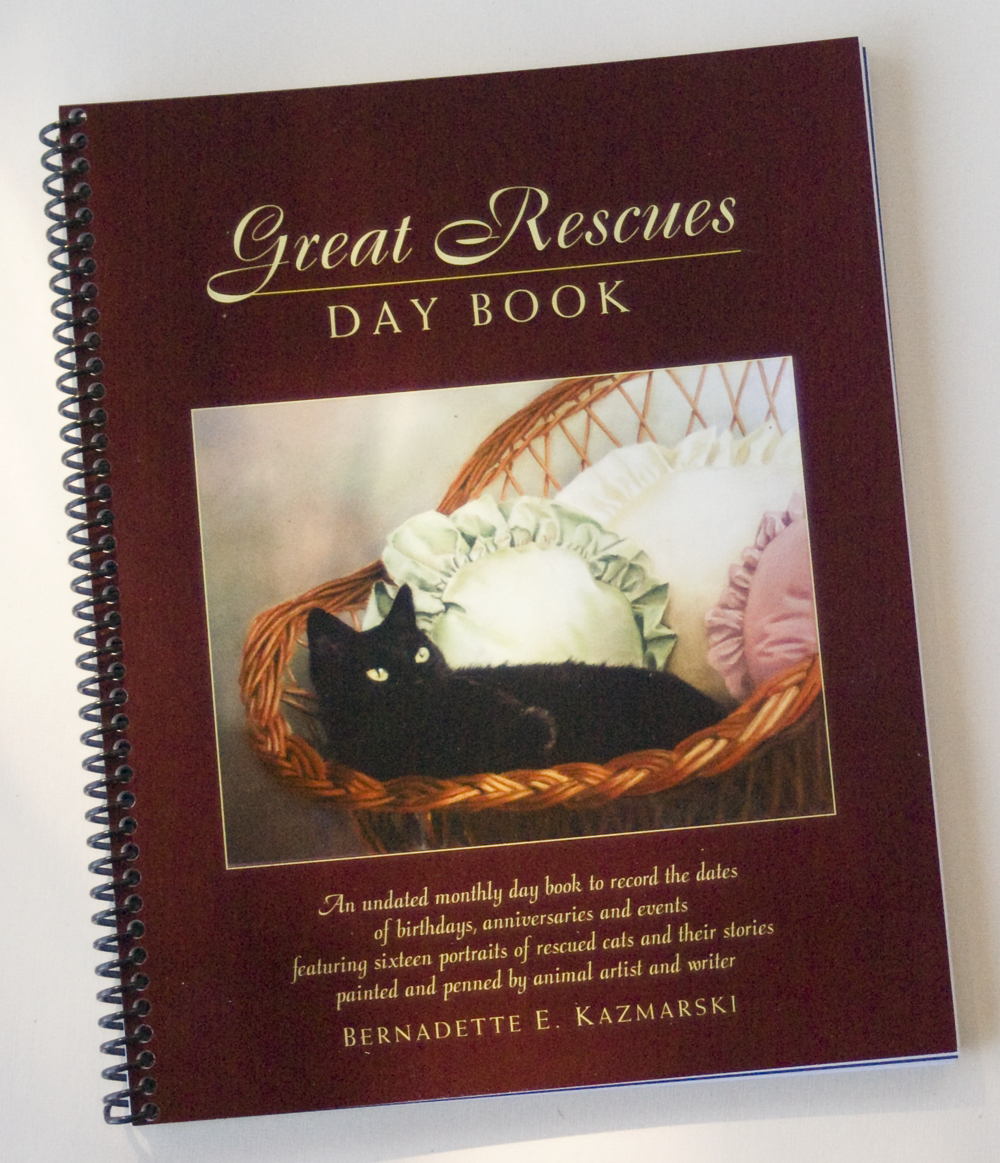
This information is part of what’s available in Great Rescues Day Book!
Each month features one of my commissioned portraits of a feline or felines and their rescue story along with a kitty quote on the left page, and on the right page the month name with enough lines for all possible dates, with standard holidays and animal-themed observances and events. Great Rescues also includes a mini cat-care book illustrated with my drawings including information on finding strays or orphaned kittens, adopting for the first time or caring for a geriatric cat, a list of household toxins and toxic plants, or helping stray and feral cats and beginning with TNR.
Each book includes also 10 sheets of my “22 Cats” decorative notepaper with a collage of all the portraits in black and white so you can make your own notes or write special notes to friends.
The portraits in this book, collected as a series, won both a Certificate of Excellence and a Muse Medallion in the 2011 Cat Writers’ Association Annual Communication Contest, as well as the 22 Cats Notepaper mentioned below.

Copyright
All images and text used on this site are copyrighted to Bernadette E. Kazmarski unless otherwise noted and may not be used without my written permission, although links to your site are more than welcome and are shared. Please ask if you are interested in using and image or story in a print or internet publication. If you are interested in purchasing a print of an image or a product including it, check my animal and nature website Portraits of Animals to see if I have it available already. If you don’t find it there, visit Ordering Custom Artwork for more information on a custom greeting card, print or other item.
Subscribe to my e-newsletter
Subscribe to The Creative Cat Preview E-newsletter.
© 2022 | www.TheCreativeCat.net | Published by Bernadette E. Kazmarski
Weekly schedule of features:
Sunday: Essays, Pet Loss, Poetry, The Artist’s Life
Monday: Adoptable Cats, TNR & Shelters
Tuesday: Rescue Stories
Wednesday: Commissioned Portrait or Featured Artwork
Thursday: New Merchandise
Friday: Book Review, Health and Welfare, Advocacy
Saturday: Your Backyard Wildlife Habitat, Living Green With Pets, Creating With Cats
And sometimes, I just throw my hands in the air and have fun!
PORTRAITS OF ANIMALS WEBSITE
FACEBOOK | TWITTER | LINKEDIN | PINTEREST | TUMBLR | INSTAGRAM | YOUTUBE| EMAIL | PATREON

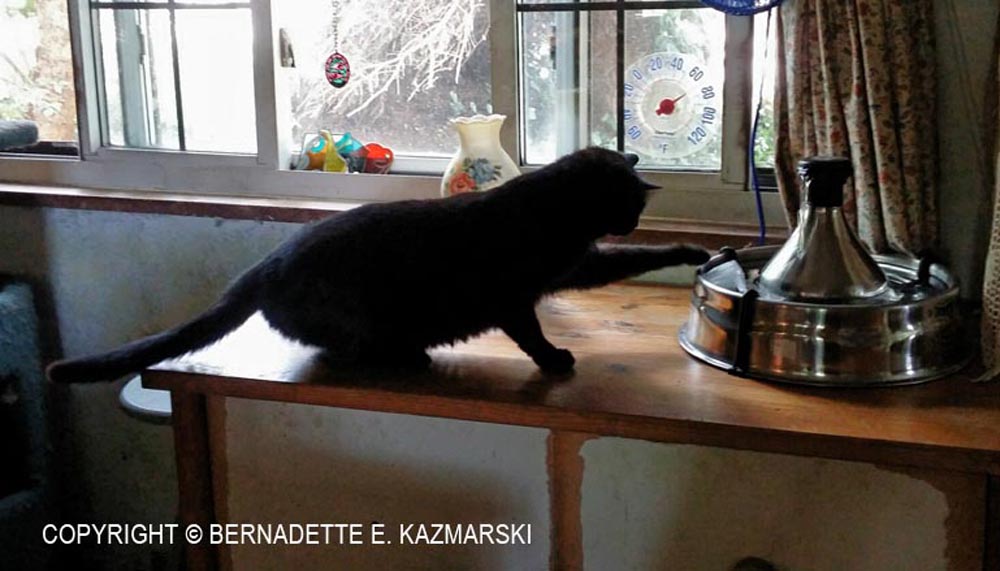


Pingback: Certificates of Excellence in CWA 2020 Communications Contest - The Creative Cat
Oh my, the photo of”Drink straight from the tap, as long as it’s water!” is hilarious!
We add filtered water to the cats’s canned food…they seem to like it slurpy…plus have water bowls here and there.
I still can’t believe I got that picture! Giuseppe still wants to drink from it too.